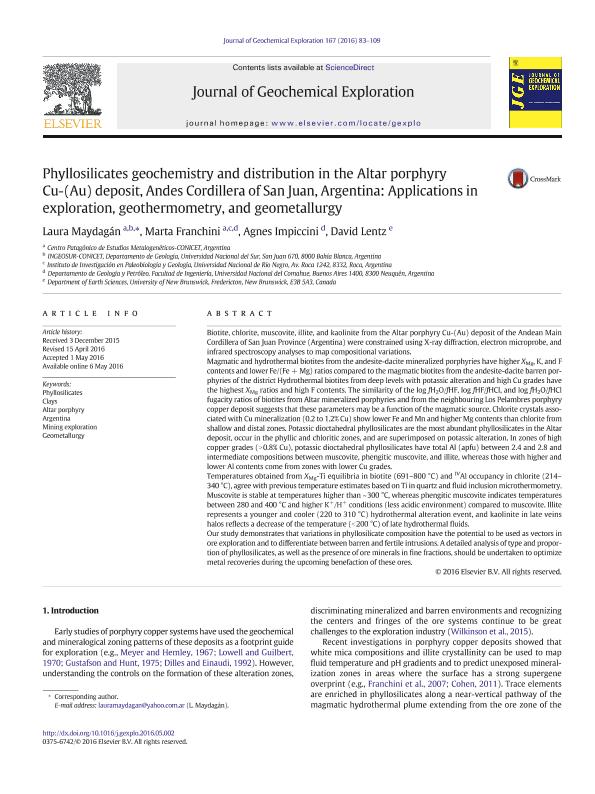Mostrar el registro sencillo del ítem
dc.contributor.author
Maydagán, Laura

dc.contributor.author
Franchini, Marta Beatriz

dc.contributor.author
Impiccini, Agnes

dc.contributor.author
Lentz, David
dc.date.available
2022-01-10T19:59:17Z
dc.date.issued
2016-08
dc.identifier.citation
Maydagán, Laura; Franchini, Marta Beatriz; Impiccini, Agnes; Lentz, David; Phyllosilicates geochemistry and distribution in the Altar porphyry Cu-(Au) deposit, Andes Cordillera of San Juan, Argentina: Applications in exploration, geothermometry, and geometallurgy; Elsevier Science; Journal of Geochemical Exploration; 167; 8-2016; 83-109
dc.identifier.issn
0375-6742
dc.identifier.uri
http://hdl.handle.net/11336/149905
dc.description.abstract
Biotite, chlorite, muscovite, illite, and kaolinite from the Altar porphyry Cu-(Au) deposit of the Andean Main Cordillera of San Juan Province (Argentina) were constrained using X-ray diffraction, electron microprobe, and infrared spectroscopy analyses to map compositional variations. Magmatic and hydrothermal biotites from the andesite-dacite mineralized porphyries have higher XMg, K, and F contents and lower Fe/(Fe+Mg) ratios compared to the magmatic biotites from the andesite-dacite barren porphyries of the district Hydrothermal biotites from deep levels with potassic alteration and high Cu grades have the highest XMg ratios and high F contents. The similarity of the log fH2O/fHF, log fHF/fHCl, and log fH2O/fHCl fugacity ratios of biotites from Altar mineralized porphyries and from the neighbouring Los Pelambres porphyry copper deposit suggests that these parameters may be a function of the magmatic source. Chlorite crystals associated with Cu mineralization (0.2 to 1.2% Cu) show lower Fe andMn and higherMg contents than chlorite from shallow and distal zones. Potassic dioctahedral phyllosilicates are the most abundant phyllosilicates in the Altardeposit, occur in the phyllic and chloritic zones, and are superimposed on potassic alteration. In zones of high copper grades (N0.8% Cu), potassic dioctahedral phyllosilicates have total Al (apfu) between 2.4 and 2.8 andintermediate compositions between muscovite, phengitic muscovite, and illite, whereas those with higher and lower Al contents come from zones with lower Cu grades. Temperatures obtained from XMg-Ti equilibria in biotite (691?800 °C) and IVAl occupancy in chlorite (214? 340 °C), agreewith previous temperature estimates based on Ti in quartz and fluid inclusion microthermometry.Muscovite is stable at temperatures higher than ~300 °C, whereas phengitic muscovite indicates temperatures between 280 and 400 °C and higher K+/H+ conditions (less acidic environment) compared to muscovite. Illite represents a younger and cooler (220 to 310 °C) hydrothermal alteration event, and kaolinite in late veins halos reflects a decrease of the temperature (b200 °C) of late hydrothermal fluids. Our study demonstrates that variations in phyllosilicate composition have the potential to be used as vectors in ore exploration and to differentiate between barren and fertile intrusions. A detailed analysis of type and proportion of phyllosilicates, as well as the presence of ore minerals in fine fractions, should be undertaken to optimize metal recoveries during the upcoming benefaction of these ores.
dc.format
application/pdf
dc.language.iso
eng
dc.publisher
Elsevier Science

dc.rights
info:eu-repo/semantics/openAccess
dc.rights.uri
https://creativecommons.org/licenses/by-nc-sa/2.5/ar/
dc.subject
PHYLLOSILICATES
dc.subject
CLAYS
dc.subject
ALTAR PORPHYRY
dc.subject
ARGENTINA
dc.subject.classification
Geociencias multidisciplinaria

dc.subject.classification
Ciencias de la Tierra y relacionadas con el Medio Ambiente

dc.subject.classification
CIENCIAS NATURALES Y EXACTAS

dc.title
Phyllosilicates geochemistry and distribution in the Altar porphyry Cu-(Au) deposit, Andes Cordillera of San Juan, Argentina: Applications in exploration, geothermometry, and geometallurgy
dc.type
info:eu-repo/semantics/article
dc.type
info:ar-repo/semantics/artículo
dc.type
info:eu-repo/semantics/publishedVersion
dc.date.updated
2021-04-23T14:04:57Z
dc.journal.volume
167
dc.journal.pagination
83-109
dc.journal.pais
Países Bajos

dc.journal.ciudad
Amsterdam
dc.description.fil
Fil: Maydagán, Laura. Consejo Nacional de Investigaciones Científicas y Técnicas. Centro Científico Tecnológico Conicet - Bahía Blanca. Instituto Geológico del Sur. Universidad Nacional del Sur. Departamento de Geología. Instituto Geológico del Sur; Argentina
dc.description.fil
Fil: Franchini, Marta Beatriz. Consejo Nacional de Investigaciones Científicas y Técnicas. Centro Científico Tecnológico Conicet - Patagonia Norte; Argentina. Universidad Nacional de Río Negro. Sede Alto Valle. Instituto de Investigaciones en Paleobiología y Geología; Argentina. Universidad Nacional del Comahue. Facultad de Ingeniería. Departamento de Geología y Petróleo; Argentina
dc.description.fil
Fil: Impiccini, Agnes. Universidad Nacional del Comahue. Facultad de Ingeniería. Departamento de Geología y Petróleo; Argentina
dc.description.fil
Fil: Lentz, David. University of New Brunswick; Canadá
dc.journal.title
Journal of Geochemical Exploration

dc.relation.alternativeid
info:eu-repo/semantics/altIdentifier/doi/https://doi.org/10.1016/j.gexplo.2016.05.002
dc.relation.alternativeid
info:eu-repo/semantics/altIdentifier/url/https://www.sciencedirect.com/science/article/pii/S0375674216300966
Archivos asociados
